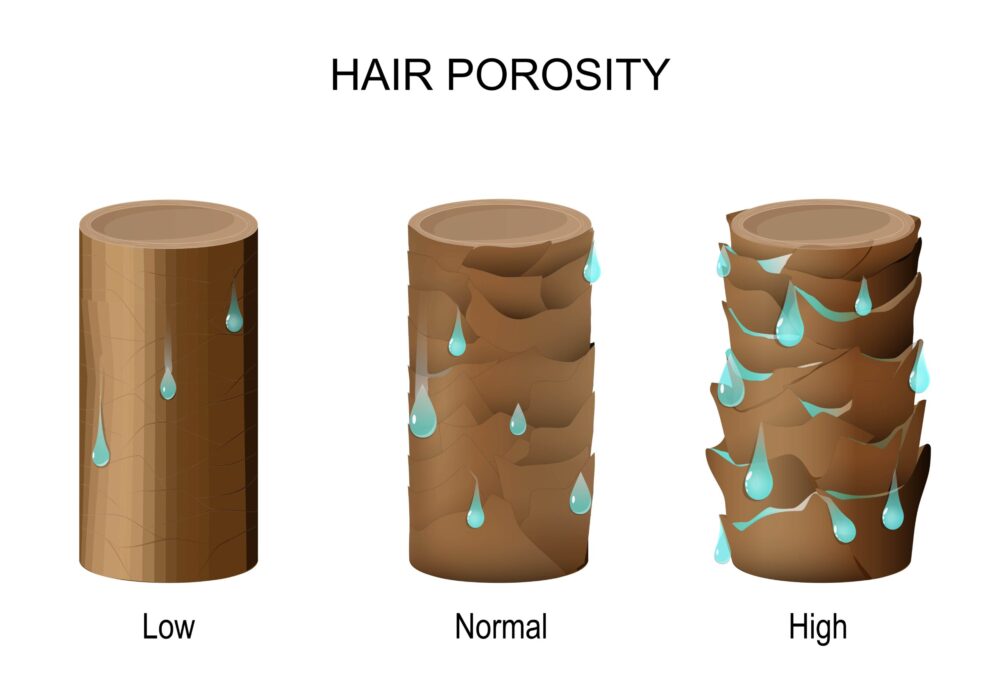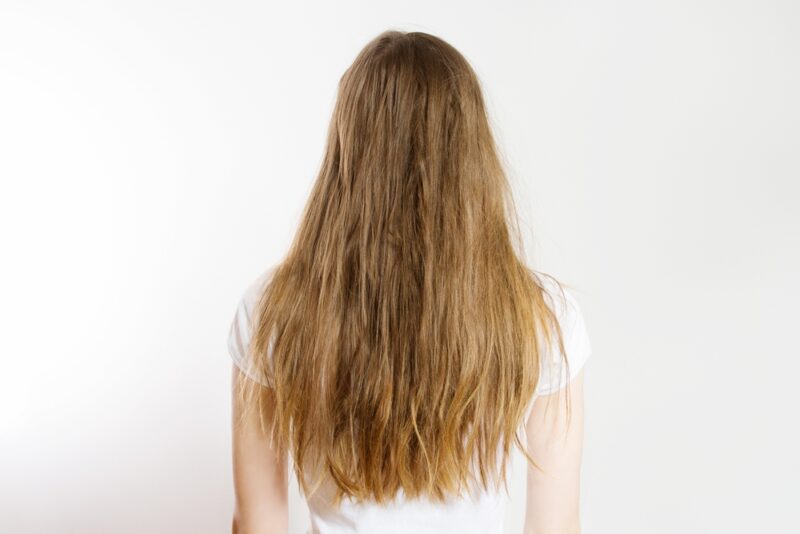Dealing with hair that feels perpetually dry? Low porosity hair, characterized by a tightly bound cuticle layer, presents unique challenges. We have seen it countless of times: it feels like a hurdle, but with the right knowledge and techniques, you can achieve soft, healthy, and vibrant hair.
At Dr. Serkan Aygin’s Clinic, we see firsthand how understanding hair structure empowers individuals to make informed choices. Let’s equip you with the strategies you need to thrive!
What is Hair Porosity?
Think of your hair strand like a sponge. Porosity determines how easily that sponge absorbs water and how long it stays damp. This ability is mainly down to the hair’s outermost layer, the cuticle. It’s made up of overlapping scales that can be tightly packed or more open.
What Does Low Porosity Mean for My Hair?
With low porosity hair, you might notice water beading up on your hair instead of being absorbed quickly. Products can sit on the surface, leading to buildup and that heavy, greasy feel, even right after washing.
Ironically, while it struggles to take moisture in, low porosity hair is also good at retaining moisture once it gets in there.
How to Know Your Porosity Level
How do you figure out where your hair stands on the porosity spectrum? Here are a few simple ways to get an idea:
- The Water Glass Test: Drop a clean strand of your hair into a glass of room temperature water.
- If it floats on top for a while, you likely have low porosity.
- If it sinks slowly, you probably have normal porosity.
- If it sinks quickly to the bottom, your hair is likely high porosity.
(Keep in mind this isn’t a definitive scientific test, but it gives a good indication.)
- The Feel Test: After washing your hair, notice how long it takes to feel fully wet. Low porosity hair often takes longer to become saturated. Also, feel how long it stays wet after washing. It might take a while to air dry.
- Product Absorption: Pay attention to how your hair reacts when you apply products. Do they sit on top without seeming to sink in? This is a common sign of low porosity.
What Does Low Hair Porosity Look Like
The Challenges (and Solutions!) of Low Porosity Hair
Low porosity hair, while strong and often less prone to breakage than high porosity hair, comes with its own set of frustrations.
Common Problems You Might Be Facing
- Product Buildup:This is a big one. Because the cuticle is so tight, products tend to sit on the hair’s surface instead of being absorbed. This can lead to a heavy, greasy feeling, even if you haven’t used much product.
- Difficulty Getting Hydrated:You might find that your hair feels consistently dry, no matter how much conditioner you use. The moisture simply isn’t penetrating the hair shaft effectively.
- Long Drying Time:Since the hair doesn’t readily absorb water, it also takes longer to dry after washing. This can be time-consuming and might even make your hair feel cold and damp for extended periods.
- Products Seem Ineffective:You might try various moisturizing products that work wonders for others, but they don’t seem to do much for your hair.
How to Finally Get Moisture In: The 5 Best Tricks for Low Porosity Hair
The key to caring for low porosity hair is to gently encourage the cuticle to open slightly so moisture can get in. Here’s how:
- Heat is Your Friend (in Moderation):Applying gentle heat can help lift the hair cuticle, allowing products to penetrate more easily.
- Deep Conditioning with Heat: Use a deep conditioner and apply a heat cap, a warm towel, or sit under a hooded dryer for 15-30 minutes.
- Steaming: Hair steaming is another excellent way to gently open the cuticle and infuse moisture into the hair shaft.
- Lightweight Products are Key:Heavy, butter-based products tend to sit on the surface of low porosity hair, leading to buildup. Opt for lightweight formulas like:
- Water-based leave-in conditioners: Look for products where water is listed as one of the first ingredients.
- Lightweight oils: Some oils are better at penetrating low porosity hair than others (more on that below).
- Serums and liquid-based stylers: These are less likely to weigh your hair down.
- Apply Products to Damp Hair:Hair is most receptive to moisture when it’s damp. Apply your leave-in conditioners and styling products while your hair is still wet.
- Focus on Hydrating Ingredients:Look for ingredients like glycerin, honey, aloe vera, and hyaluronic acid in your hair products. These are humectants that attract and retain moisture.
- Clarify Regularly:Because of the tendency for product buildup, it’s important to use a clarifying shampoo every few weeks to remove residue and allow products to penetrate more effectively.
Oils That Actually Work: Your Guide to the Best Oils for Low Porosity Hair
Lightweight oils with smaller molecules are more likely to penetrate the hair shaft without just sitting on the surface. Here are some excellent choices:
- Grapeseed Oil: This is a very light and easily absorbed oil that won’t weigh your hair down.
- Argan Oil: Often called “liquid gold,” argan oil is lightweight and rich in vitamin E and fatty acids that can penetrate the hair shaft.
- Sweet Almond Oil: Another light oil that absorbs well and adds shine without greasiness.
- Jojoba Oil: This oil is structurally very similar to the sebum our scalp naturally produces, allowing it to be easily absorbed.
- Apricot Kernel Oil: A light and nourishing oil that can help soften the hair.
Surprising Fact: Did you know that some studies suggest that certain oils can actually penetrate the hair shaft and reduce protein loss? Choosing the right oil isn’t just about moisture; it’s about overall hair health!
Shampoo Saviors: Top Picks
The right shampoo for low porosity hair will cleanse effectively without stripping too much moisture, which can further dry out your already moisture-resistant strands. Look for:
- Sulfate-free formulas: Harsh sulfates can be too drying. Opt for gentler cleansing agents.
- Clarifying shampoos (used occasionally): To remove buildup, a clarifying shampoo is essential, but don’t use it too frequently as it can strip moisture.
- Lightweight moisturizing shampoos: Some sulfate-free shampoos contain light moisturizing ingredients that won’t weigh the hair down.
Tip: Pay attention to how your hair feels after shampooing. If it feels very stripped and squeaky clean, it might be too harsh for your low porosity hair.
The Low-Down on Washing: How Often Should You Wash Low Porosity Hair?
There’s no magic number, and it depends on your scalp and lifestyle. However, because low porosity hair tends to experience more product buildup and doesn’t dry out as quickly, you might find that washing less frequently works best.
- Listen to your scalp: If your scalp feels oily or you notice significant product buildup, it’s time to wash.
- Consider co-washing (conditioner washing): Some people with low porosity hair find that skipping shampoo altogether and using a lightweight conditioner to cleanse their scalp works well.
- Experiment: Start by washing once or twice a week and adjust based on how your hair and scalp feel.
Home Remedies That Can Make a Difference
You don’t always need expensive products to care for low porosity hair. Some simple home remedies can be surprisingly effective:
- Apple Cider Vinegar (ACV) Rinse: Diluted ACV (1 part ACV to 3-4 parts water) can help to gently clarify the scalp and hair, removing buildup and potentially helping to slightly open the cuticle. Use it sparingly, once every 2-4 weeks.
- Aloe Vera Juice or Gel: Aloe vera is incredibly hydrating and lightweight. You can use pure aloe vera juice as a leave-in spritz or mix aloe vera gel into your deep conditioner for an extra boost of moisture.
- Honey Mask: Honey is a natural humectant, meaning it attracts moisture. Mix a tablespoon of raw honey with a few tablespoons of water or your favorite conditioner and apply it to damp hair for 15-20 minutes before rinsing. The gentle heat from your scalp can help it penetrate.
Ingredient Intel: What Not to Use
Knowing what to avoid is just as important as knowing what to use. For low porosity hair, steer clear of:
- Heavy Butters and Oils: Think shea butter, coconut oil (for some – it can sit on the surface), and heavy mineral oil. These can create a barrier and prevent moisture from entering.
- Silicones (especially non-water-soluble ones): While silicones can provide slip and shine, non-water-soluble silicones can build up on low porosity hair, making it feel heavy and preventing moisture absorption over time. Look for ingredients ending in “-cone” that are not preceded by “PEG-” or “dimethicone copolyol,” as these are usually water-soluble.
- Very Thick and Creamy Products: These often contain heavy ingredients that will just coat the hair. Opt for lighter, more fluid consistencies.
By understanding these challenges, embracing the right techniques, and choosing lightweight, hydrating products, you can overcome the hurdles of low porosity hair and achieve the healthy, moisturized locks you desire!
Deeper Dive & FAQs
What Hair Type Usually Has Low Porosity?
Generally, straight hair (Type 1) is the hair type that is more prone to having low porosity. This is so for 2 reasons:
- Tighter Cuticle: The smooth and flat structure of straight hair means the cuticle layers are usually very tightly packed together. This makes it harder for moisture to penetrate.
- Sebum Distribution: The natural oils (sebum) produced by the scalp can easily travel down the straight hair shaft, often providing enough surface-level lubrication that the hair doesn’t “need” to absorb as much external moisture.
Why Did My Hair Become Low Porosity?
Low porosity is primarily genetic, determined by your hair’s natural structure. However, excessive use of heavy, occlusive products can sometimes create a barrier, mimicking low porosity over time. Heat damage can also slightly alter the cuticle.
What are the Symptoms of Low Porosity Hair?
Symptoms include hair that takes a long time to fully wet, products sitting on the surface, slow drying time, and hair that often feels dry and stiff despite product use. Buildup is also common.


